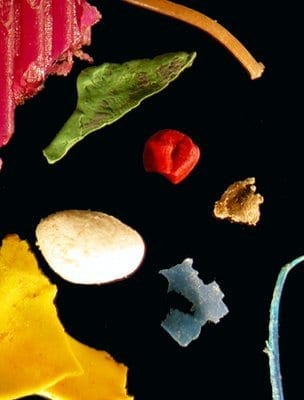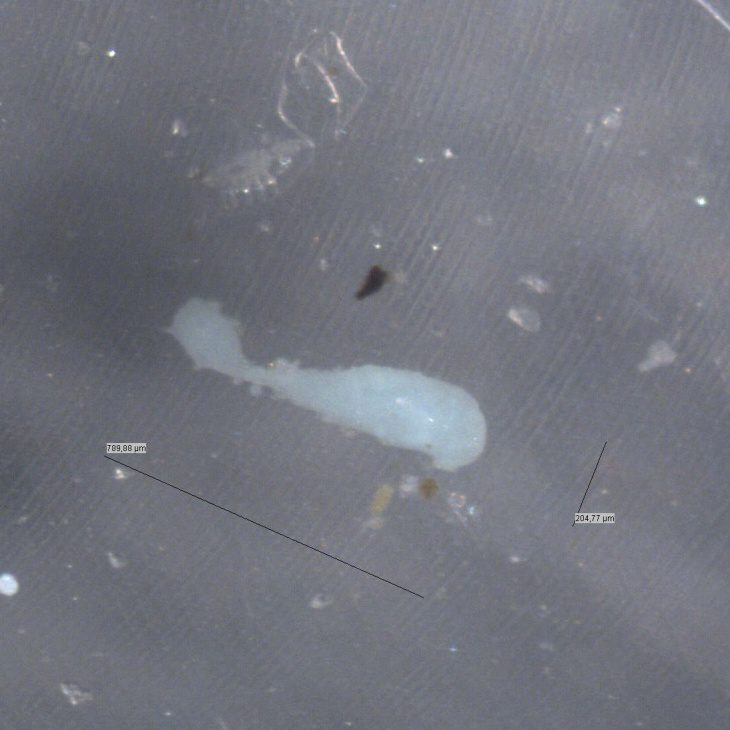
Tiny particles of waste plastic that are ingested by shoreline “eco-engineer” worms may be negatively affecting biodiversity, a study says.
So-called microplastics may be able to transfer toxic pollutants and chemicals into the guts of lugworms, reducing the animals’ functions.
An estimated 150 million tonnes vanishes from the global waste-stream each year.
The findings have been published in the academic journal Current Biology.
“We are losing a large volume of plastic and we know it is going into the environment and the assumption being made by policymakers is that this material is non-hazardous, it has got the same ranking as scraps of food,” explained co-author Mark Browne, an ecologist from the US-based National Center for Ecological Analysis and Synthesis.
“The research we have done really challenges that,” Dr Browne added, referring to the findings of lab work carried out by colleagues at Plymouth University, UK, led by co-author Prof Richard Thompson.
“Our findings show that the plastic itself can be a problem and can affect organisms.
“Also, when particles of plastic go into the environment what you find is that they accumulate large quantities of pollutants that are banned. So you have these particles themselves but also a load of nasty chemicals.”
Important role
The team found that the tiny bits of plastic, which measure 1mm or smaller, transferred pollutants and additive chemicals – such as flame-retardants – into the guts of lugworms (Arenicola marina).
This process results in the chemical reaching the creatures’ tissue, causing a range of biological effects such as thermal stress and the inability to consume as much sediment.
Dr Browne explained that this had consequences for the surrounding ecosystem.
The Latest on: Microplastics
- Tiny tenacious robots snatch bacteria and microplastics out of the wateron May 8, 2024 at 1:57 pm
Scientists have developed tiny "robots" which appear to be very effective at removing microplastics pollution from water. What's more, the little bots also target the harmful bacteria that often hitch ...
- Swarms of miniature robots clean up microplastics and microbes, simultaneouslyon May 8, 2024 at 8:14 am
When old food packaging, discarded children's toys and other mismanaged plastic waste break down into microplastics, they become even harder to clean up from oceans and waterways. These tiny bits of ...
- America has a $250 billion problem: Microplastics have invaded our bloodstreams and may increase the risk of heart attack and strokeon May 8, 2024 at 7:52 am
For all the damage that microplastics are doing to the planet, it may be that only an impending threat to the human body will direct the kind of attention to the issue that it has long deserved. That ...
- Magnetic microrobot swarms clean water of microplastics and bacteriaon May 8, 2024 at 6:02 am
Microplastics are one of the biggest environmental and health risks faced by our generation. Now, researchers have developed swarms of tiny robots, or microrobots, that not only microplastics from ...
- Swarms of miniature robots clean up microplastics and microbes, simultaneously (video)on May 8, 2024 at 5:31 am
Swarms of magnetically controlled microrobots removed both microplastics and microbes from water. And the bots could be decontaminated and reused. This is a promising approach for decontaminating ...
- Microplastics are everywhere, even in your bloodstreamon May 7, 2024 at 2:15 am
As the film unravels, audiences are made scarily aware of the presence of microplastics in food, soil, clothes, blood, feces and daily household items. More shockingly, the film captures microplastics ...
- 'Everywhere we looked, we found evidence': Microplastics expert on 20 years of pollution researchon May 6, 2024 at 9:14 am
Thirty years ago, while counting barnacles, limpets and seaweeds along rocky shores, I started noticing a daily tide of litter, mostly plastic. As a marine biology Ph.D. student at Liverpool ...
- Microplastics: A looming threat to our well-beingon May 1, 2024 at 3:17 am
The pervasive presence of microplastics in our environment has become an issue of global concern, prompting urgent action from scientists, policymakers, and individuals alike. These tiny plastic ...
- Toxic chemicals from microplastics can be absorbed by the skin, study findson April 26, 2024 at 8:20 am
A new study used 3D human skin-equivalent models to examine how flame retardant additives in microplastics are absorbed by the skin. The findings show that several flame-retardant additives passed ...
- What are microplastics doing to human health? Scientists work to connect the dotson April 26, 2024 at 1:01 am
People unknowingly ingest microplastics from what we eat, drink and breathe. Some scientists fear exposure to microplastics could increase vulnerability to heart disease, cancer and other illnesses.
via Bing News
The Latest on: Microplastic pollution
- Built-in washing machine filters quick fix to microplastic problem, advocates sayon May 8, 2024 at 3:02 pm
The Micfofiber Filter Rebate Act provides a rebate for the cost of the microfiber washing machine filter or replacement filter. There are also after-market filters you can already purchase, as well as ...
- Scientists explore nature’s promise in combating plastic wasteon May 8, 2024 at 6:36 am
These filters could remove plastic contamination from drinking water, and prevent microplastic pollution in industrial and domestic wastewater from reaching rivers and oceans. Plastic-degrading ...
- How Some Companies Are Making Textiles More Sustainableon May 7, 2024 at 6:02 am
Collectively, textiles are responsible for around 5% to 10% of global greenhouse gas emissions, according to researchers at Massachusetts Institute of Technology—more than shipping and aviation ...
- IAEA Director General Visits Chile to Sign Agreements on Plastic Pollution and Lithium Miningon May 2, 2024 at 9:11 am
IAEA Director General Rafael Mariano Grossi and the Foreign Minister of Chile, Alberto van Klaveren, signed a Memorandum of Understanding to tackle plastic pollution in Antarctica on Tuesday. (Photo: ...
- The Environment Agency Abu Dhabi Assesses Microplastic Levels In Abu Dhabi's Marine Environmenton April 30, 2024 at 6:50 am
The Environment Agency – Abu Dhabi (EAD) and the Abu Dhabi Quality and Conformity Council (QCC) announced a landmark partnership to address the growing global challenge of microplastic pollution in ...
- Hydrogel to tackle microplastic pollutionon April 29, 2024 at 3:39 pm
Researchers from Indian Institute of Science (IISc) have designed a sustainable hydrogel to remove tiny plastic particles from water using UV light irradiation. The hydrogel consists of intertwined ...
- Toxic microplastic hotspots found in Long Island Sound by CT nonprofit advocacy groupon April 28, 2024 at 2:00 am
The nonprofit Rozalia Project for a Clean Ocean found that most of the plastics in Long Island Sound probably started out as polyester fabrics.
- Student project brings awareness to microfiber pollutionon April 25, 2024 at 6:34 pm
The Microfiber Initiative began in February and seeks to raise awareness of the microplastics released into the environment from textiles as a result of washing clothes.
- Forensic Science Techniques Used to ID Microplastic ‘Hotspots’ in Open Waterson April 16, 2024 at 5:01 pm
Collaboration between forensic and environmental experts results in a new method to identify microplastic pollution hotspots in open waters. Study in Long Island Sound: Technique trialed in the ...
- Microplastic 'hotspots' identified in Long Island Soundon April 9, 2024 at 5:00 pm
Forensic and environmental experts have teamed up to develop a new scientific method to pinpoint microplastic pollution 'hotspots' in open waters. Forensic and environmental experts have teamed up ...
via Bing News










